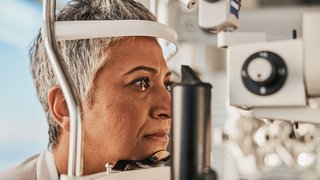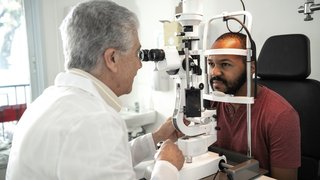Corneal collagen cross-linking for keratoconus helps patients see better, longer
June 19, 2019

Symptoms of keratoconus, a degenerative eye disease, can begin in patients as young as 14. The disease is progressive, which means deformities in the cornea (the transparent front layer of the eye) will cause it to continually bow outward over time without treatment.
However, corneal collagen cross-linking – an advanced procedure approved by the U.S. Food and Drug Administration (FDA) in 2016 – can vastly improve vision in patients of all ages. Corneal collagen cross-linking (CXL) is not a cure for keratoconus, but it can help prevent the condition from getting worse. CXL is intended to prevent steepening or progression of the keratoconus process to potentially avoid needing a corneal transplant.
Unlike some other vision disorders, keratoconus affects how light enters the eye and can distort how that light is interpreted by the brain. But CXL is actually a treatment to help strengthen the cornea to decrease or halt disease progression.
How does corneal collagen cross-linking work?
Corneal collagen cross-linking is an in-office procedure that usually takes an hour or less. The ophthalmologist will put a few drops in your eyes to numb them and remove a thin layer of epithelium, or the tissue that covers the cornea of your eye. The FDA has approved this “epi-off” approach, which some ophthalmologists think will help the eyes better absorb medicated drops.
Next, the doctor will administer eye drops of riboflavin, also known as vitamin B2, to help the corneal tissue better absorb light. After the drops settle in, you will be asked to lie back and look up into a special ultraviolet light.
The combination of the riboflavin and ultraviolet light strengthens the cornea by increasing the number of chemical links between the fibers of the eye and the cornea. As the cornea becomes stronger, the bulging of the cornea is prevented from getting worse.
After a CXL procedure, you might need to wear custom-fit contact lenses designed for patients with keratoconus.
'Unlike some other vision disorders, keratoconus affects how light enters the eye and can distort how that light is interpreted by the brain. But CXL is actually a treatment to help strengthen the cornea to decrease or halt disease progression.'
Katrina Parker, O.D. and Steven Verity, M.D.
Why do patients need special contacts?
Traditional soft lenses are designed to fit the average person’s eye, but the eyes of patients with keratoconus are shaped differently before and after CXL.
Patients can get custom-fitted contacts from specially trained optometrists at UT Southwestern who work with patients at all stages of managing keratoconus and other eye conditions. Depending on the severity of keratoconus, patients can be managed with specialty soft contact lenses, rigid gas permeable (RGP) lenses, or scleral lenses.
RGP lenses are smaller in diameter than soft lenses and rest directly on the cornea, providing a smoother front surface for light to enter and focus in the eye. Scleral lenses are made of the same material as RGP lenses but are larger in diameter. Instead of resting directly on the cornea, scleral lenses vault over the cornea and rest on the white part of the eye called the sclera.
These lenses also provide a smooth, regular surface for light to focus in the eye and are filled with a preservative-free saline solution that can help mask corneal irregularities. Some patients with keratoconus also have other ocular conditions, such as dry eye syndrome, and the fluid reservoir can help keep the eye lubricated and comfortable during lens wear.
Successful treatment requires a team effort
Patients with keratoconus and other lifelong eye conditions require the care of several specialists to help reduce symptoms, slow disease progression, and get the most advanced treatment.
At our academic medical center, every patient has access to ophthalmologists, optometrists, and other eye-care experts who collaborate to recommend the most effective treatment option for each patient. This continuity of care, from diagnosis to long-term management, gives patients and doctors the opportunity to work together on personalized care plans.
While corneal collagen cross-linking can help mitigate the severity of keratoconus, some patients eventually will need a corneal transplant. Approximately 40,000 corneal transplants are performed each year in the U.S., making it a relatively common procedure.
As with many diseases, early risk detection and proper diagnosis leads to more successful management of keratoconus.
To find out whether you or a loved one might benefit from the keratoconus treatments and services provided by UT Southwestern, call 214-645-2020 or request an appointment online.












